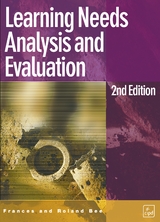
TRAINING NEEDS ANALYSIS EVAL
Seiten
1994
Chartered Institute of Personnel & Development (Verlag)
978-0-85292-547-8 (ISBN)
Chartered Institute of Personnel & Development (Verlag)
978-0-85292-547-8 (ISBN)
- Keine Verlagsinformationen verfügbar
- Artikel merken
Zu diesem Artikel existiert eine Nachauflage
Using many examples, this practical guide describes a systematic four-stage evaluation process which allows managers to assess whether training has been successfully transferred to the workplace, whether it serves organizational objectives and provides value for money.
Companies of every size devote much time and effort - and sometimes huge budgets - to training. Yet since it remains rare for needs, methods and results to be assessed systematically, it is often impossible to determine the return on this investment. The answer, argue Roland and Francis Bee, is to go back to first principles. Training needs must be driven from business needs and a corporate strategy developed in response to internal and external stimuli. Data generated by appraisal systems, manpower and succession plans help define the performance gap. Once the need has been clearly specified, all the more technical issues - should the training be formal or informal, designed specifically or brought off the shelf? Who is the best supplier? - fall easily into place. A systematic four-stage evaluation process then allows managers to assess whether training has been successfully transfered to the workplace, whether it serves organisational objectives and provides value for money. All this is set out in a clear practical guide drawing on many examples from the authors' own in-house and consultancy experience. For anyone who hopes to harness training initiatives to organisational goals, there could be no better place to start.
Companies of every size devote much time and effort - and sometimes huge budgets - to training. Yet since it remains rare for needs, methods and results to be assessed systematically, it is often impossible to determine the return on this investment. The answer, argue Roland and Francis Bee, is to go back to first principles. Training needs must be driven from business needs and a corporate strategy developed in response to internal and external stimuli. Data generated by appraisal systems, manpower and succession plans help define the performance gap. Once the need has been clearly specified, all the more technical issues - should the training be formal or informal, designed specifically or brought off the shelf? Who is the best supplier? - fall easily into place. A systematic four-stage evaluation process then allows managers to assess whether training has been successfully transfered to the workplace, whether it serves organisational objectives and provides value for money. All this is set out in a clear practical guide drawing on many examples from the authors' own in-house and consultancy experience. For anyone who hopes to harness training initiatives to organisational goals, there could be no better place to start.
Business needs: the driving force
Identifying training needs: translating business needs into action
Specifying training needs
Translating training needs into training action
Planning the training
Evaluating the training
| Erscheint lt. Verlag | 16.6.1994 |
|---|---|
| Zusatzinfo | 17figs.10tabs. |
| Verlagsort | Wimbledon |
| Sprache | englisch |
| Themenwelt | Sozialwissenschaften ► Pädagogik ► Berufspädagogik |
| Wirtschaft ► Betriebswirtschaft / Management ► Personalwesen | |
| ISBN-10 | 0-85292-547-6 / 0852925476 |
| ISBN-13 | 978-0-85292-547-8 / 9780852925478 |
| Zustand | Neuware |
| Haben Sie eine Frage zum Produkt? |
Mehr entdecken
aus dem Bereich
aus dem Bereich
Buch | Softcover (2022)
Schlütersche (Verlag)
CHF 73,90
Buch | Softcover (2020)
Christiani, Paul (Verlag)
CHF 38,75
Fragen und Antworten zur Prüfungsvorbereitung für die Kurse …
Buch | Softcover (2023)
Deutsche Vereinigung für Wasserwirtschaft, Abwasser und … (Verlag)
CHF 67,90



